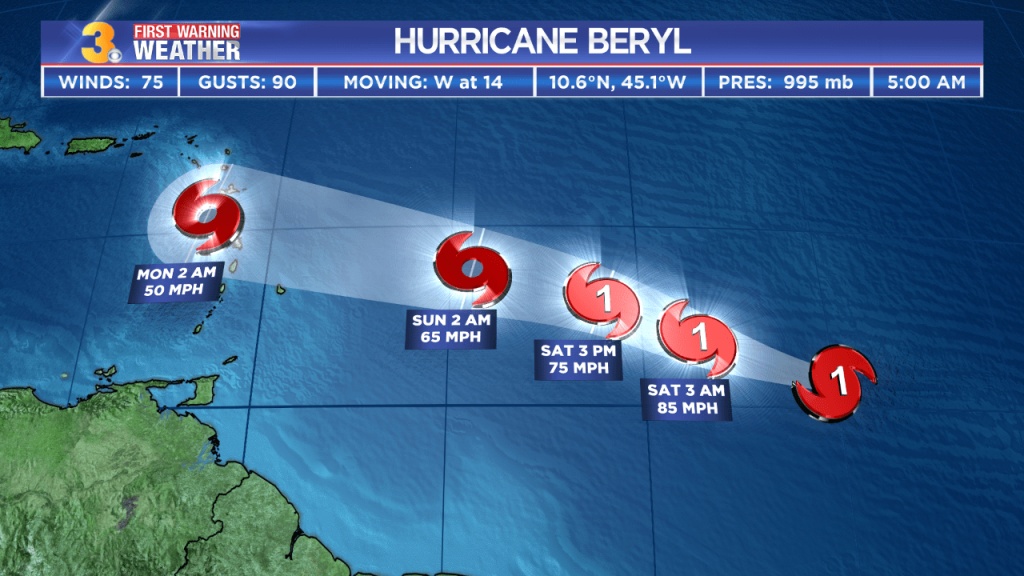Hurricane Beryl’s Impact on Barbados
Hurricane beryl barbados – Hurricane Beryl, a Category 1 hurricane, made landfall in Barbados on July 18, 2018. The storm brought heavy rains, strong winds, and storm surges, causing widespread damage across the island.
Hurricane Beryl made landfall in Barbados, causing significant damage. For more information on the history of hurricanes in Barbados, please refer to barbados hurricane. The storm brought heavy rains and winds, which resulted in flooding and power outages. Fortunately, there were no reported fatalities.
The most severely affected areas were the southern and eastern parishes of Barbados, including Christ Church, St. Philip, and St. Andrew. These areas experienced the brunt of the storm’s winds and rainfall, resulting in significant damage to homes, businesses, and infrastructure.
The hurricane season is in full swing, and the Caribbean has already been hit by several storms. One of the most recent was Hurricane Beryl, which passed just south of Barbados. The storm brought heavy rains and winds to the island, but thankfully no major damage was reported.
Hurricane Beryl Barbados was a reminder that the hurricane season is not over yet, and residents of the Caribbean should be prepared for more storms in the coming weeks.
Damage to Infrastructure, Hurricane beryl barbados
Hurricane Beryl caused extensive damage to Barbados’ infrastructure. The storm’s strong winds uprooted trees, downed power lines, and damaged roads and bridges. In some areas, the storm surge caused flooding and erosion, damaging coastal roads and infrastructure.
Damage to Property
Hurricane Beryl also caused significant damage to property in Barbados. Many homes and businesses were damaged or destroyed by the storm’s winds and rain. The storm surge also caused flooding and damage to coastal properties.
Recovery Efforts in Barbados after Hurricane Beryl

In the aftermath of Hurricane Beryl, Barbados swiftly initiated comprehensive recovery efforts to address the immediate needs of affected communities and lay the groundwork for long-term rebuilding.
Immediate Response and Relief Efforts
Immediately following the hurricane’s impact, the government and relief organizations mobilized resources to provide emergency assistance. This included:
- Distribution of food, water, and shelter supplies
- Establishment of evacuation centers and medical facilities
- Deployment of security forces to maintain order and assist with recovery operations
Long-Term Recovery Plans and Initiatives
Beyond the immediate response, the government of Barbados developed a comprehensive recovery plan that encompassed:
- Infrastructure repair and rebuilding, including roads, bridges, and power lines
- Housing assistance for those who lost their homes
- Economic recovery initiatives to support businesses and stimulate growth
- Environmental restoration projects to address damage to coastal ecosystems
Challenges Faced During the Recovery Process
The recovery process in Barbados was not without its challenges. These included:
- Limited resources and funding for rebuilding efforts
- Delays in accessing international aid
- Challenges in coordinating the efforts of various agencies and organizations
Despite these challenges, the government and people of Barbados demonstrated resilience and determination in their recovery efforts. With the support of international partners, they worked tirelessly to rebuild their communities and create a more resilient future for the island nation.
Lessons Learned from Hurricane Beryl: Hurricane Beryl Barbados

Hurricane Beryl’s impact on Barbados in 2018 highlighted the need for improved disaster preparedness and response strategies. Key lessons learned from the hurricane include the importance of:
- Early warning systems: Timely and accurate warnings allow for early evacuation and mitigation measures.
- Resilient infrastructure: Buildings, roads, and utilities should be designed and constructed to withstand hurricane-force winds and flooding.
- Emergency response coordination: Clear communication and coordination among government agencies, emergency services, and community organizations are crucial for effective response.
Mitigation Measures for Future Hurricanes
To mitigate the effects of future hurricanes, Barbados can implement measures such as:
- Strengthening building codes: Enforcing stricter building codes to ensure structures can withstand hurricane-force winds and flooding.
- Improving drainage systems: Upgrading drainage systems to prevent flooding and minimize damage to infrastructure.
- Investing in renewable energy: Reducing reliance on fossil fuels by investing in renewable energy sources, such as solar and wind power, to maintain essential services during power outages.
Recommendations for Improved Disaster Preparedness and Response
To enhance disaster preparedness and response, Barbados can consider the following recommendations:
- Public education and awareness: Educating the public about hurricane hazards, preparedness measures, and evacuation plans.
- Community resilience programs: Establishing community-based programs to promote neighborhood preparedness and disaster response.
- Regular disaster drills and exercises: Conducting regular drills and exercises to test and improve emergency response plans.